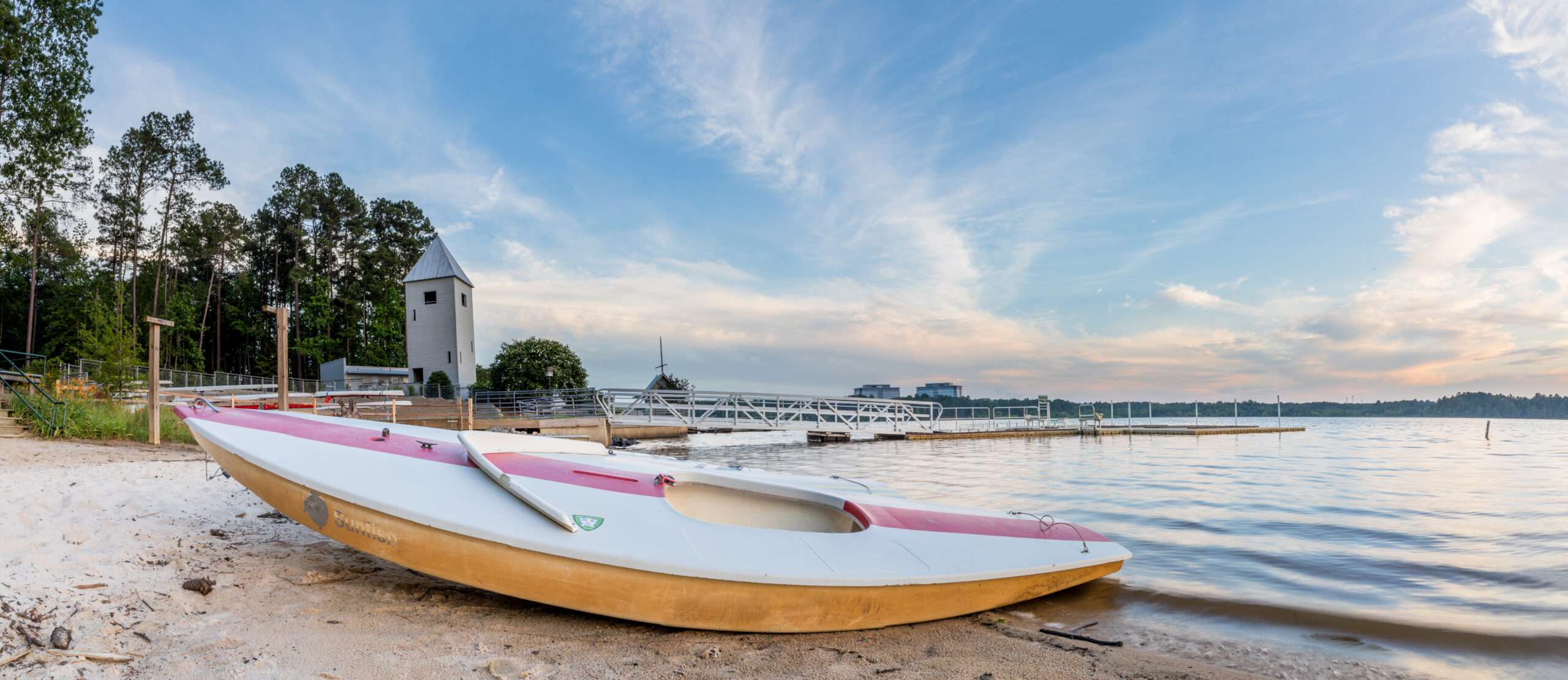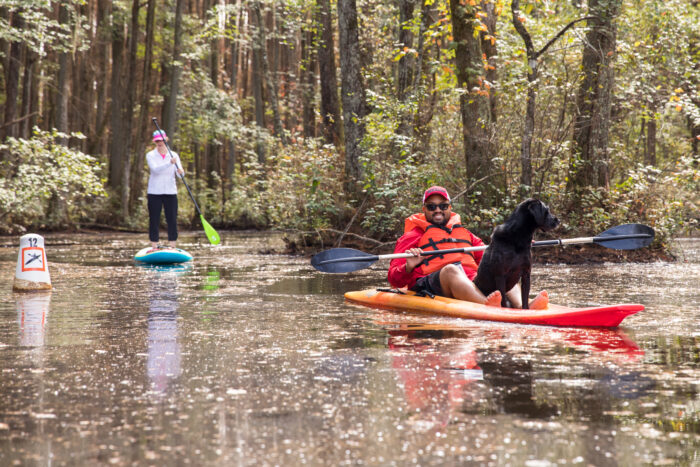Prioritizing Play and Cultivating Community
Wake County’s Approach to Facilitating Parks, Recreation, and Open Space
By Carl Wilkins | NCACC Strategic Communications Specialist

Lake Crabtree County Park, Wake County
When we think of county services, we often think of the essential services that counties provide for their residents to survive, such as law enforcement, public health, and public safety. But what about the services counties provide to ensure residents are thriving beyond their basic needs? Parks, recreation, and open spaces are just that. According to the National Recreation and Park Association, parks and recreation are an essential service that provides economic value, health and environmental benefits, and social importance, enhancing the community’s quality of life. The outdoor recreation industry contributes $28 billion to North Carolina’s economy and our counties understand the value parks and recreation adds to our great state.
Parks, recreation, and open spaces are resources and services for leisure, entertainment, and recreational pursuits; these resources may be public spaces and facilities like parks, nature preserves, open space areas, greenways, trails, and built structures for sport, recreation, or arts programs. In North Carolina, parks and recreation departments can be organized in several ways, such as county-managed, city-managed, or a combination of the two.
One of North Carolina’s most populous counties, Wake County, has come a long way in its journey to preserve open space, promote stewardship, and provide equitable and inclusive education and outdoor recreation for a diverse and growing community.
Initially, when Wake County’s Parks, Recreation and Open Space Department started as an entity in the mid-1970s, it didn’t have any permanent staff or parks; it was only comprised of a parks and recreation committee appointed by Wake County Board of Commissioners to distribute funds. Wake County implemented a partnership and grants-based model that allocated funds from the county to municipalities and community organizations such as the Boys and Girls Club and YMCA to lead the development of these recreational resources for residents. Wake County also provided consultation to help community organizations plan parks and invested in a team of landscape architects to assist in the design, planning, and construction phases.
Wake County’s fruitful partnership-based model continued to expand with the development of the “Community Use of Schools Program,” which encourages and/or incentivizes the community use of school buildings and property for recreation or other purposes. This partnership enabled Wake County’s Public School System to provide services to the community that are typically outside the standard mission of public education. For example, this could be the county in-vesting money in constructing a public school’s new football field and allowing the local adult flag football league to rent it out for their needs during non-school hours. It is an excellent service that facilitates educational, recreational, cultural, civic, and social programs for all age groups.
Fast forward over 50 years, and Wake County has transitioned from a small parks and recreation committee to a county-managed department with full-time staff and eight parks and three nature preserves, totaling over 2,600 acres for the public to enjoy. However, as a county park department, Wake County is more like state parks than municipal parks, meaning their parks are more natural resource based. Wake County doesn’t generally build gymnasiums, community centers, or ball fields; instead, the strategy is to let the land dictate their actions and leave other types of assets to the municipalities. The county focuses on enhancing nature’s offerings by developing things like mountain bike trails, kayaking opportunities, and nature exploration. Wake County has prioritized open space preservation and is committed to protecting 30% of its land for recreation. Wake County’s preservation promise is a significant commitment that requires proactive planning, vision, and strong relationships with municipalities and developers.
Like many North Carolina counties, Wake County is growing fast, and more than 1 million people call it home. Wake County is proactively protecting land because it could quickly become too late to preserve it. Wake County has invested over $90 million in protecting open space through three bond referendums; and has intentionally invested in land and relationships with developers to ensure residents have what’s important to them.
According to Wake County’s Community Survey, designed to identify the county’s residents’ most critical issues, 87.8% of respondents agreed that “access to parks and public spaces” was important for the growth and sustainability of Wake County—additionally, 33.8% of respondents stated that “access to parks” was their primary reason for living in Wake County.
Wake County residents agree that the county’s investment in open space has paid off. Since COVID-19 Wake County has had record visitation in their parks and open spaces, and it hasn’t wavered.
However, when you are rapidly growing and serving a large, diverse community, the county must guarantee that its public spaces are equitable and inclusive. Wake County’s Parks, Recreation and Open Space Diversity, Inclusion, and Equitability (DEI) initiative, called “Everyone’s Welcome,” has been a great way to ensure race, color, national origin, gender identity, age, religion, sex, disability, and experience are taken into account when providing services for residents.
To define these values, Wake County borrows a phrase from Robert Sellers, Chief Diversity Officer at the University of Michigan who states, “diversity is where everyone is invited to the party. Equity means that everyone gets to contribute to the playlist. Inclusion means that everyone has the opportunity to dance.”
There isn’t a one-plan-fits-all parks department strategy for all North Carolina’s communities. Wake County’s adherence to DEI looks different in the varying parks, and each community or municipality within the county has specific resources to meet its residents’ needs. For some communities, that could be more services for an aging population, such as pickleball courts; for others, it could be offering programs and services that are accessible to everyone, such as focusing on programming with adherence to Americans with Disability Act (ADA) standards.
In partnership with Wake County, the Town of Morrisville Parks, Recreation & Cultural Resources Department has listened to the wants of its diverse community. According to Morrisville, the town’s demographics are approximately 46% Asian Indian, 35% white, 10% African-American, and 9% other. Morrisville understood its community and partnered with Wake County to provide 31% of the land cost to develop a cricket pitch at Church Street Park instead of the usual basketball courts or soccer fields. The county and city made an unprecedented investment in one of the world’s most popular sports, cricket, played worldwide, particularly in England, Australia, India, Pakistan, and the West Indies.
Morrisville’s Church Street Park is now one of the few cricket pitches on the east coast and one of only two hosts for Major League Cricket games in the United States. Morrisville’s investment in DEI and parks has paid off and now garners national attention and tourism. The Town of Morrisville’s Church Street Park is an excellent example of effective county partnerships and gives an example of adaptability in parks administration to provide innovative services for residents.
Every North Carolina county is different, but there are some parks and recreation best practices that every county can implement no matter their size or resources.

Robertson Millpond Preserve, Wake County
Partnerships
There is only so much a county can accomplish without the support of its municipalities and community partners. Wake County Parks, Recreation and Open Space Department primarily partners with its municipalities to purchase up to 50% of the land cost. For example, the county’s robust and famous greenway system is only possible in Wake County through effective partnerships between the county and its municipalities. Wake County and its municipalities have agreed to a 50/50 split for the total cost to develop greenways. Similar partnerships have been struck across the state to connect all 900-plus miles of North Carolina’s greenway system. It is crucial for counties to reach out to municipalities and neighboring counties to share best practices and garner new ideas. Additionally, counties should look for community partners such as local nonprofits focused on health and wellness to explore how they can work together towards a common goal. All partnerships are different; however, counties must explore their options to find what’s best for their residents.
Technical Assistance
North Carolina State Recreation Resources Service (RRS) is the nation’s oldest technical assistance program for parks and recreation agencies. Its mission is to “encourage excellence in recreation, parks, and outdoor space design with a goal to foster public health and inclusivity by providing knowledge and technical expertise.” It is provided through a partnership of the Division of Park and Recreation-North Carolina Department of Natural & Cultural Resources and North Carolina State University’s Department of Parks, Recreation & Tourism Management. RRS is a fantastic resource for counties and government agencies looking to receive assistance in establishing, improving, or expanding parks and recreation services.
“The RRS is a full-service resource for county parks and recreation professionals that can help in any step of the process from planning to implementation. We are an objective resource and a great starting point for counties looking to invest in or enhance their parks, recreation, and leisure services,” states Dr. Charlynne Smith, Director of North Carolina State Recreation Resources Service.
North Carolina counties work hard to ensure that residents’ needs are not just met but surpassed and that they aren’t just surviving but thriving. According to the National Recreation and Parks Association, parks and nature preserves are unique resources that promote residents’ health and well-being, drive county economic opportunity, and strengthen community. Wake County has shown how these investments in nature, relationships, and community have paid off.
“As Wake County continues to grow at a rapid pace, it’s more important than ever that we find ways to protect open space and expand access to parks, preserves, recreation resources and greenways for all of our residents,” said Shinica Thomas, Chair of the Wake County Board of Commissioners. “From hiking and biking to kayaking and horseback riding, there’s truly something for everyone at our Wake County parks and preserves.”
Click here to read the full PDF version of the Summer 2023 issue of CountyQuarterly.
If you’d like to receive print versions of CountyQuarterly, subscribe at this link.
